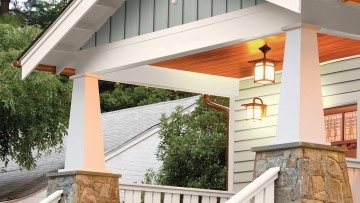
In Depth: Trim & Moulding
Despite pandemic challenges, the market looks healthy for the decorative trim segment.
If you want to understand the staying power of the moulding and trim industry, you’ll need to look far back in time. The ancient Greeks extensively used mouldings to adorn their temples such as the Parthenon, and in fact, two types of Greek S-shaped moulding—the outward-curving “cyma recta” and the inward-curving “cyma reversa”—are still in use today.
Fast forward a few thousand years, and you’ll find an industry that is as vibrant and popular now as it was then. And with access to materials and manufacturing processes that those ancient craftsmen could never imagine, it’s now possible for trim makers to quickly adapt to both market changes and aesthetic shifts in a fraction of the time compared to even just a few decades ago—a good thing, considering the challenges that the industry has faced over the past twelve months.
Growth in the midst of challenges
If the last year will be remembered for anything, it will be for the impact of COVID-19. Beyond the obvious health crisis the virus brought on, it should come as no surprise that the virus also had a profound impact on the building and remodeling industries. “COVID-19 has affected how nearly everyone works,” says Ben Drury, brand manager for Boral Building Products. “But it’s been remarkable to see the industry adjust and take necessary steps to keep customers supplied safely.”
Those adjustments, however, have not happened overnight, and challenges remain. Says Nam Ong, vice president and general manager of AZEK Exteriors, “The sudden slow down, and shut down in some states, of construction from March until May without a doubt caused disruption with the supply/demand balance across the industry. With a strong market pre-COVID, everyone in the supply chain, from manufacturer to contractor, had to re-evaluate their situation and adjust their plans going forward.”
Ian Daniels, director of technical support for Tamlyn, echoes Ong’s thoughts on supply challenges. “The impact has been up and down the supply chain, and while everything has continued to move forward, the pace of things has slowed,” he says. “Suppliers have had some delays as different plants/operations might have been hit with an outbreak, or depending on local response to COVID-19. Some of our fabrication partners have been hit with staffing issues, but some are also seeing an increase in demand.”
Mark Echols, general manager of moulding and millwork for BlueLinx, also sees supply issues continuing for 2021. “COVID-19 has negatively impacted the supply chain for all products,” he says. “Import and domestic mills have struggled to operate efficiently with new social distancing regulations and downtimes related to COVID-19 cases within their plants. Short supply, allocation, and increases in cost are still an everyday challenge.” Despite these upheavals, the trim category is anticipated to have significant growth over the next twelve months—and beyond. “When the pandemic started and the initial shutdowns began, there was definitely disruption to supply chains and a brief dip in the market,” says Peter Cobucci, construction business unit manager for Palram Americas. “After the first few months, however, business had bounced back surprisingly strong, and looks to have a positive growth forecast moving forward.”
Industry statistics seem to agree with Cobucci. According to Research Reports World’s recent report entitled “2020-2025 Global Molding And Trim Market Report – Production And Consumption Professional Analysis (Impact Of Covid-19)”, the global Molding and Trim market is anticipated to rise at a considerable rate during the forecast period, between 2021 and 2025. And according to a recent Bank of America poll about homeowners’ attitudes and shopping habits during coronavirus, more than 70% of those polled indicated they had decided to tackle home improvement projects, with more planned for 2021.
“After a very concerning first half of the year due to COVID, as an industry, we’ve been very fortunate to end up having record levels of demand during the second half of 2020,” says Andres Alarcon, millwork sales director for Arauco North America. “Both the repair and remodel and the new construction segments are driving this demand. We expect these trends to remain in place for at least the first half of next year, allowing the category to possibly grow even above the record levels of 2020.”
Boral’s Drury shares that optimism. “As stay-at-home recommendations stretch through the winter, we expect the surge in demand to remain as homeowners continue to seek to make their homes their sanctuary and buyers scoop up new and existing homes that meet their changing lifestyle needs.
But lead times should continue to improve as manufacturers catch up, and supply challenges should ease.”
Bold colors, clean designs
When it comes to trends for moulding and trim, many of last year’s product drivers remain in play for 2021. Darker trim colors that complement soothing color schemes remain popular, with trim colors in the gray, dark blue and green palettes increasing in popularity along with the ever-classic white and black. “There’s still a strong desire for multi-textured facades as well as contrasting siding and trim colors,” says Drury, “and Boral’s TruExterior Trim and Kleer Lumber trimboards are a perfect fit for those color combinations. TruExterior Trim’s poly-ash technology allows it to be painted any color, including black, so it’s perfect for the white-siding-with-dark trim trend.”
Steve Booz, vice president of marketing and product innovation for Royal Building Products, also sees bold colors remaining a strong player for 2021, but also sees a softening of those hues as compared to last year. “For exteriors, dark colors on home exteriors have been trending for a few years,” he says, “but we are seeing a slight shift in hues. Trends are moving away from charcoals to dark blues. Add bold trim, and you’ve got a home ready for 2021.”
Bold colors aren’t limited to exterior use, however. “We are also seeing homeowners getting creative with their interior trim and moulding and using dark, bold colors like navy blue and dark, rich greens on their interior walls,” Booz points out. “Bold monochrome interior trim, which we saw become popular in 2020, will continue to be popular moving into 2021.”
As well, the popularity of craftsman styles and the “modern farmhouse” look remain in high demand, with profiles that favor a more simplistic aesthetic that embraces simplicity and clean lines. “The biggest trend in millwork (interior or exterior) continues to be Craftsman, which can be seen in both exterior and interior design trends,” says Booz. “Our trim options with clean, bold lines make this a stunning interior feature for any room and a welcome transition from Colonial style trim.”
And like the trends for color and design styles, trim materials seem to be following a similar path as last year. According to “Moulding and Trim in the U.S. by Material, Product, Market and Region, 7th Edition” from Research And Markets, wood will remain the leading moulding and trim material through 2022. Other alternatives, however, are making significant gains, especially due to their ease of installation and low-maintenance qualities.
Engineered wood and PVC are expected to record above average sales gains through 2022. “With many builders and remodelers facing rising costs for wood materials as well as labor shortages, the demand for PVC products continues to increase,” says Royal’s Booz. “PVC trim and moulding products are easy to install and maintain, making them an advantageous product for builders who want to meet consumer demand for a high-end look, within a reasonable timeframe and budget.”
But let’s not forget aluminum. While more common in multifamily/ commercial projects, manufacturers are seeing an increased interest in the use of extruded aluminum trim for single-family and smaller-scale multifamily builds. “This trend had started a little as people have taken the detailing from commercial projects and looked for ways to adapt that to residential, with extruded aluminum as an easy entry for both exterior and interior,” explains Tamlyn’s Ian Daniels. “Still, some of the drive and growth might also be a shift in project trend due to COVID-19, making people reexamine/ shift how and where they want to live. The work-from-home trend that has resulted from COVID-19 we think might also play a factor as we keep going in the next 12 months in the commercial market as to what projects are permitted and brought out of the ground, including some slowdown certain sectors.”
To read more of this article go to...
https://lbmjournal.com/in-dept...
